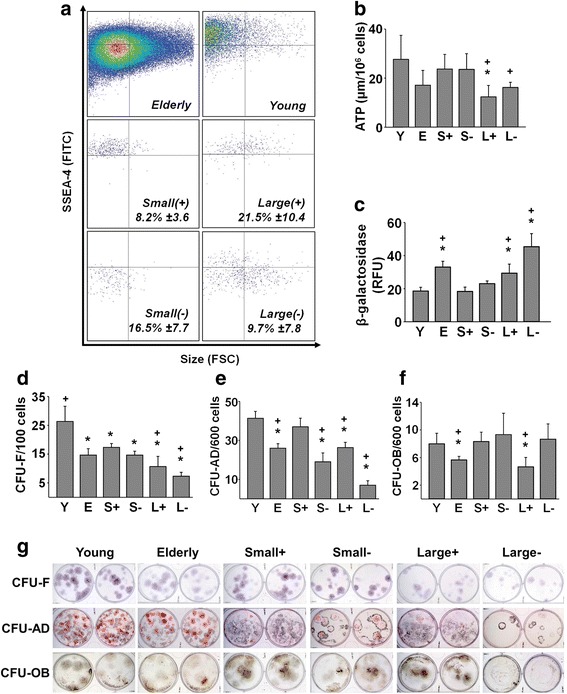Fig. 2.

A subpopulation of elderly MSCs can be isolated using FACS that exhibits a “youthful” phenotype. a Flow cytometry revealed that young MSCs consisted almost exclusively of small, SSEA-4+ (small(+)) cells (top-right panel, upper-left quadrant), while elderly MSCs were more heterogeneous (top-left panel). After sorting elderly MSCs by size (small vs large) and SSEA-4 expression (positive vs negative), four subpopulations were obtained (lower four panels). Mean ± SD of each subpopulation shown; small(+) cells represented on average 8.2% of the elderly MSCs (n = 16 donors (11 elderly, five young) tested in replicate experiments). b, c After isolation, the unfractionated young and elderly MSCs and four subpopulations (S+, S–, L+, L–) were assayed for ATP content and β-galactosidase expression. Compared to elderly MSCs, ATP levels tended to be higher in young MSCs and the small(+) and small(–) subpopulations, but these differences did not achieve statistical significance. In contrast, large(+), but not large(–), cells contained significantly lower levels of ATP than young or small(+) MSCs (P = 0.021). β-galactosidase expression was significantly increased in the elderly MSCs and large(+) and large(–) subpopulations, compared to young and small(+) MSCs, suggesting the presence of senescent cells (n = 10 donors (five elderly, five young) tested in replicate experiments). d–g CFU assays (CFU-F, CFU-AD, and CFU-OB) were performed immediately after isolation to determine the enrichment of MSCs. Young MSCs consistently formed more colonies than elderly MSCs in all assays. Small(+) cells were equivalent to young MSCs in the CFU-AD and CFU-OB assays (n = 10 donors (five elderly, five young)). *P < 0.05, vs young MSCs; +P < 0.05, vs small(+) MSCs. S small, L large, Y young, E elderly, RFU relative fluorescence units, CFU colony forming unit, F fibroblast, AD adipocyte, OB osteoblast, ATP adenosine triphosphate, ROS reactive oxygen species, SSEA-4 stage-specific embryonic antigen-4
